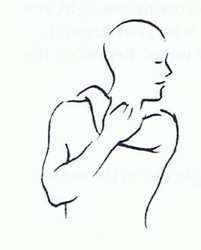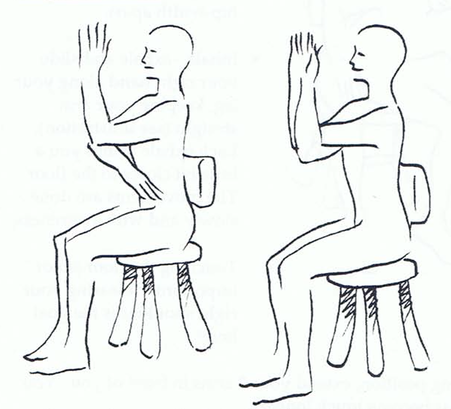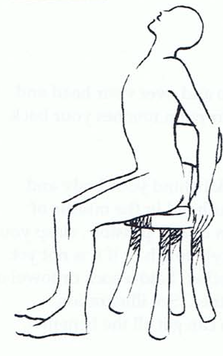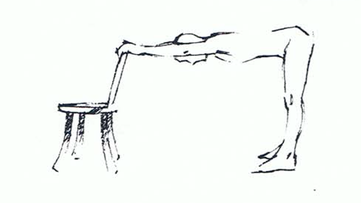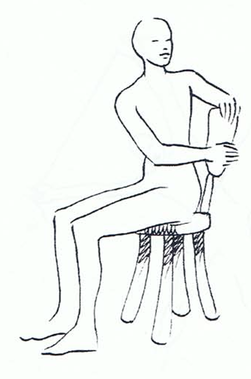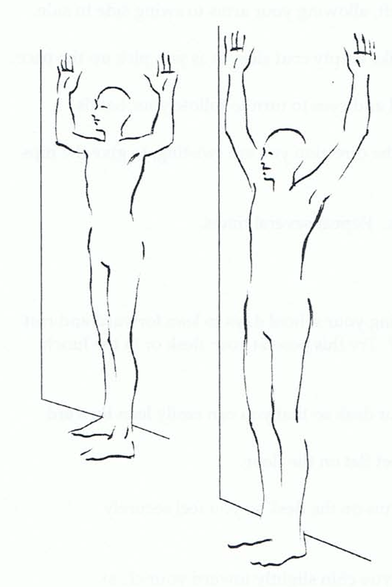An Island of Serenity: A Practical Guide
This excerpt is from a comprehensive 42-page booklet. To request the entire booklet, contact Elisabeth.
Stretching Exercises
Head
Eye Exercises
Stand or sit comfortably. Keeping your head still, look upward as high as possible.
Hold your eyes in this position for a moment, then look downward as far as you can.
Repeat several times. Close your eyes and relax.
Look to the extreme right corner of the eye sockets and hold. Then look to the left.
Repeat several times. Close your eyes and relax.
Next, move your eyes in a clockwise direction several times, then repeat in a counterclockwise direction.
Close your eyes and relax.Rub your palms together vigorously until you feel the warmth.
Then place your palms over your eyes and allow the warmth to penetrate into your eyes, relaxing all of the muscles around your eyes.
Making a Face
This is to be done in the privacy of your own room.
Open your mouth and your eyes as wide as possible.
Hold the stretch for a few seconds and release. This will bring energy into your face and you will feel rejuvenated.
Head
Turn your head to the right, pause for a few seconds, come back to centre, turn your head to the left, hold for a few seconds and come back to centre. Repeat at least 3 times.
Inhale and lift your head up, look at the ceiling.
Exhale, lower your chin to your chest.
Feel the stretch in the back of your neck. Repeat this movement slowly at least 3 times.
Looking straight ahead, inhale deeply.
Exhale, tilt your head to the right, bring your right hand on top of your head; let the weight of your hand gently pull your head towards your right shoulder.
Feel the stretch on the left side of your neck.
Inhale, come back to centre. Exhale, repeat the exercise on the left.
The Pendulum
Drop your chin to your chest.
Turn your head slowly from right to left as you breathe deeply in and out. Feel the stretch at the back of your neck.
Babette’s Embrace
Hold your left arm just above the elbow with your right hand.
Gently pull your elbow towards your right shoulder and, if your neck allows you, look over your left shoulder.
Hold the stretch for 10 seconds and repeat on the other side.
Upper Back
Eagle’s Arms
Bring the left elbow over the right and intertwine the arms until palms come together. If your hands don’t meet, hold a belt, sock or small towel in your right hand and grasp it with your left hand at a comfortable height.
Move your arms from side to side, then up and down and then circling them in one direction and then the other.
Repeat the exercise bringing the right elbow over the right and intertwining the arms until palms come together.
Chest Expanders
The Fish
Sit in a chair with your spine erect. Your two feet are firmly planted on the floor.
Hold the sides of your chair as in the illustration.
Inhale, and pushing on the chair with your hands, lift the chest towards the ceiling bending the torso backwards.
Exhale and slowly come back to your starting position.
Repeat a few times, slowly and with attention to the needs of your body. If one time is enough, listen to your body – it is not the quantity that is important but the quality of the movement.
Cat Stretch
Sit up straight, with your knees slightly separated and your feet flat on the floor.
Grasp your knees with your hands.
Breathe in deeply, arch your back and look up.
Breathe out as you bend the opposite way, round your back and tuck your chin into your chest.
Repeat 5 times.
Variation on Cat Stretch
Same exercise standing and holding on to the top of a chair.
Seated Twist
Sit with a straight back at the front of your chair.
Inhale – exhale, twist to the left and place both hands on the back or on the side of the chair.
Look over your left shoulder. You are using the chair as leverage. Make sure your left shoulder is relaxed.
Hold the position for a few seconds and relax.
Repeat on the other side.
Knee to Forehead
Sit as straight as possible.
Bring your left knee towards your chest and clasp it with your two hands.
Inhale – exhale and drop your head towards your left knee. Do not force anything – again, getting the head to the knee is not the goal. The process is more important.
After doing it several times, relax and repeat on the other side.
Tip: Do not do this exercise on a full stomach. The pressure on your abdomen may cause discomfort or nausea.
Arm Raises at the Wall
Stand erect with your back to the wall, your heels a few inches from the baseboard. Your shoulders and buttocks should touch the wall.
Raise your bent arms along the wall
Keep your elbows and wrists in contact with the wall and straighten your arms (as in illustration).
Slowly lower your arms to the starting position. When you move up and down, use your breath – inhaling up, and exhaling down.
This exercise is excellent to do when we feel “the weight of the day” on our shoulders. It allows us to keep our spine erect and open our chest.
Breathing Exercises
Breath is the wonderful gift we receive at birth, and it is our companion all our life. But are we aware of it? For one thing, we take it for granted until we get sick with a throat infection, a cold or asthma! Then we realize the miracle of the breath. We can exist for a few days without liquid or food, but we would only last a few minutes without air. As we breathe in oxygen we nourish the body cells and as we breathe out carbon dioxide, we remove toxins from the body cells. On the in-breath energy is sent through the bloodstream to the vital organs, the glands and nerve centres.
Breathing through the nostrils is recommended as it filters germs and impurities and helps prevent sickness. Doing the yoga breathing exercises we feel invigorated, rejuvenated and at the same time serene and peaceful.
Breathing is linked to our emotions. If we are excited, our heart rate will accelerate and the breath will be more shallow, and vice-versa. We can control our emotions through our breathing. Deep breathing can help us remain calm in the midst of a turmoil of activities. When we regulate our breathing, we remain centred, ready to face challenges with poise and vibrant energy.
Take a moment now to witness your breathing. Put your hand on your abdomen and breathe slowly and deeply through your nose. Feel the abdomen billow out in all directions. Close your eyes and listen to your breath. Receive the life breath in …. Even this little exercise will do wonders as a stress management tool.
Tips for Breathing Exercises
Practice the exercises in small doses, but quite frequently.
Choose the ones you like, stick to them.
Do them as long as it is comfortable.
Do them when you feel ‘low’.
Do them when you feel tired, or depleted.
Do them when you need to ease your tension.
Do not overdo them until you feel uncomfortable.
Do not wait until emotion or physical exertion wears you out. Deal with it before it overcomes you.
Most importantly, enjoy these exercises! They have been designed for your pleasure and well-being.
Relaxing Breathing Exercises
The Full Breath Exercise
This exercise will help you deepen your breathing, as you will breathe from your abdomen, rib cage and upper chest.
Sit comfortably in a chair and make sure your back, neck and head are in a straight line.
Place your hands on your abdomen.
Slowly inhale through your nose and feel your abdomen inflate like a balloon and deflate on the exhale.
Repeat the breath 10 times.
Then put your hands on your rib cage (keep your shoulders relaxed) and slowly inhale and feel the ribcage expand, like an umbrella opening inside your torso.
Exhale and feel it retract.
Repeat the breath 10 times.
Finally, put your hands underneath the collarbone and feel the breath rise to the upper chest.
Repeat the breath 10 times.
Then, release your hands and feel the breath move through your body like a wave – from the abdomen, into the rib cage and up to the collarbone.
Slowly inhale with the full breath to a count of 5 and exhale slowly to a count of 5. You can slowly increase the number of counts to 10.
Variation of the Full Breath Exercise
Breathe in slowly for 5 counts; hold the breath for 5 counts (relax your body while holding your breath) and exhale slowly for 5 counts.
The Ocean Breath (one of my favourites!)
I learned this technique at the Kripalu Centre for Yoga and Health: This breath is performed by taking long, slow and deep breaths while slightly contracting the back of the throat in the area of the glottis. This subtle muscular contraction creates a hissing sound in the back of the throat that sounds like the rising and falling of the ocean tide. Let’s try a little experiment:
Put one hand in front of your face and imagine it is a mirror. Your aim is to fog the mirror.
Open your mouth and exhale a long “Ha” as if to send steam on the mirror.
Repeat a couple of times.
Alternate Nostril Breathing
This breathing technique helps unblock the nostrils and ease breathing difficulties. It is also a powerful cleansing and re-energizing exercise, which will leave you feeling clear-headed and calm.
Using the right hand, (if you are right-handed), use the thumb to close the right nostril and the ring finger to close the left nostril.
You can tuck the 2 middle fingers into the palm of your hand or rest them on the forehead (see illustration).
Close the right nostril with your thumb and gently exhale. Then, inhale through your left nostril.
Next, close your left nostril with your ring finger, exhale gently and inhale through your right nostril.
Repeat the alternate motion for as long as you want. Feel the effect of the calming breath. This breath helps alleviate headaches, migraines, and generally frazzled states of being.
More Invigorating Breathing Exercises
Sunshine Breath
Sitting straight on a chair, or standing with your two feet hip-width apart, inhale (using the ocean breath).
Slowly raise your arms out to the sides and up overhead bringing palms to face each other.
Exhale.
Turn your palms away from each other and slowly return them to your sides.
Coordinate the movement of your arms with the breath so that one full inhalation (about 6 counts) brings your arms all the way up and one full exhalation takes the arms all the way down.
Repeat several times.
Breath of Joy
Coming into a relaxed stance with your feet comfortably apart, inhale raising your arms in front of you to shoulder-height.
Inhale a little more, open the arms out to the sides.
Inhale even more, raise your arms overhead, and then exhale as you swing your arms down towards the ground, bending forward from the hips.
Repeat 4 times.
Floor Exercises
When we feel very tired, “low”, or overwhelmed, lying on the floor is the best thing we can do. The floor is there to support us, take our worries, and receive our weight.
Sacral Massage
Lie on your back with your legs straight and your feet together.
Breathe deeply. Pull your knees in towards your chest. Press down through your lower spine. Press out through the crown of your head and lengthen the back of your neck.
Roll from side to side so that you get a massage of the lower back.
Inhale. Release your legs back to the starting position, pressing out through your heels.
Knee to Chest Pose
Lie on your back with your legs straight and your feet together.
Exhale.
Bring your left knee up to your chest.
Interlace your fingers below your knee and hug your knee firmly.
Breathe deeply.
Pull your knee in toward the left side of your chest.
Press out through the crown of your head and lengthen the back of your neck.
Relax your right leg.
Inhale.
Release your leg back to the starting position.
Repeat on the right side.
Please contact Elisabeth if you would like to purchase a copy of the booklet.

